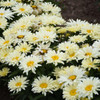Product Description
Leucanthemum superbum 'Seventh Heaven' PPAF (30)ct Flat
Common Name: Shasta Daisy
Lemon yellow buds open to large 4" wide creamy white flowers. Three rows of petals on each flower overlap for a very full look. Lateral branching produces a second flush of flowers that extends time in color. Vernalization is required for the best performance.
Shasta Daisies are all-time favorites for the perennial border. They mix so effortlessly with other perennials that no garden should be without them!
Leucanthemums require full sun and well-drained soil to be at their best. Winter drainage is especially important; planting in raised beds will help to provide these conditions. Shastas make good perennials for Southern gardens, though partial shade is recommended in the warmest zones.
Height: 20.0-22.0 Inches
Spread: 22.0-24.0 Inches
Hardiness Zones: 5,6,7,8,9
Flower Color: Yellow Shades
Foliage Color: Green shades
Full Sun
Low to Average Water Needs
Average to Fertile Soil Quality
Bloomtime: Early - Midsummer
Attracts Butterflies
Bee Friendly
Growth Rate: Medium
Border Plant, Container, Cut Flower, Easy To Grow
Leucanthemum 'Seventh Heaven' is a beautiful and popular Shasta daisy known for its large, double, creamy white flowers. Here is a breakdown of its features and care:
Description and Details
- Appearance: 'Seventh Heaven' boasts large, fully double flowers with multiple layers of petals, creating a very full and showy appearance. The flowers are a creamy white, sometimes with a slight hint of pink blush, and have a bright yellow center.
- Size: It typically grows to about 22-24 inches tall and wide.
- Flowers: The flowers are large, reaching up to 4 inches in diameter, and bloom profusely from early summer to fall.
- Hardiness Zones: Hardy in zones 5-9.
- Light: Prefers full sun (at least 6 hours of direct sunlight daily).
- Soil: Thrives in well-drained soil.
Native Habitat
- Shasta daisies, including 'Seventh Heaven', are hybrids derived from various Leucanthemum species, which are native to Europe.
Landscaping Design Tips
- Borders and Edging: Its compact size and abundant blooms make it a great choice for edging pathways or creating low borders.
- Cottage Gardens: A perfect addition to cottage-style gardens, adding a touch of classic charm.
- Cut Flower Gardens: The long stems and long-lasting flowers make it excellent for cutting gardens.
- Mixed Beds: It mixes well with other sun-loving perennials in mixed beds and borders.
- Container Gardening: Can be grown in containers, allowing you to enjoy its beauty on patios or balconies.
Planting and Care
- Planting:
- Choose a sunny spot with well-drained soil.
- Plant in spring or fall.
- Space plants about 18-24 inches apart.
- Care:
- Water regularly until established, then water as needed, allowing the soil to dry slightly between waterings.
- Deadhead spent flowers to encourage continuous blooming.
- Divide clumps every few years to maintain vigor.
- Fertilize lightly in spring.
Additional Information
- 'Seventh Heaven' is a vigorous and reliable bloomer, providing a long-lasting display of beautiful flowers.
- It is attractive to butterflies and other pollinators.
- Shasta daisies are deer-resistant.
Important Note: When planting Shasta daisies, ensure your soil is well-drained, as they do not tolerate soggy conditions. Deadheading is key to promoting continuous blooming throughout the season.
Thirty (30) plants per flat (or tray). Approximate Plug Measurements: 3 inches deep x 2 inches wide.
Other Details
The most important part of the plant is its root system. Healthy roots are the foundation of a healthy, vibrant plant. The type of plug container used is based on the specific needs of the plants. Perennials offered as bare root traditionally perform better when planted as bare root.Planted in a specialized mix, potted plants have well established root systems. Top growth stage will vary depending on the current life cycle and time of year when shipped. In Winter and early Spring dormant plants may be shipped. Dormant plants may be planted right away, even before the last frost date.
Most bare root varieties are field grown for at least one season, though Hemerocallis and Hosta are grown for two seasons. The bulk of the soil is removed during the harvesting process and the tops of most varieties are trimmed back to the crown. They are graded, packed in shredded aspen or sphagnum moss and stored in freezers until ready to be shipped.
See our Container Sizes and Bare Root Perennials pages for more information.
Plant information and care is provided in the Overview section, Plant Genus Page and general information is provided in the Planting Care & Guides. Additional questions can be asked on each Plant page.
Plant Spacing: Using the maximum mature spread or width of a plant to guide spacing, ensures space to grow to full size. To fill an area sooner, plant them closer together. Just remember, future thinning or transplanting may be needed.
Water: Keep a close eye on newly planted perennials, especially throughout the first growing year. Most early plant loss is due to too much or too little water!












